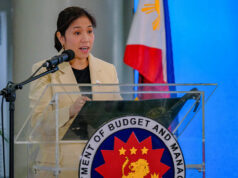On tinkering with the anthem and the flag
Senate President Tito Sotto (he of Eat Bulaga fame) has proposed revising the final lines of the Philippine national anthem. He thinks the original lyrics, written in 1898 by Julian Felipe (“Aming ligaya na pag may mangaapi, ang mamatay nang dahil sa iyo”) is defeatist. Instead he has proposed the lines, “…ang ipaglaban ang kalayaan mo.”
The fact that the phrase stumbles due to an incorrect measure isn’t the only problem with the Sotto proposal. But it would be futile arguing this with Sotto. Recall how he insisted that directly translating a quotable quote without proper attribution is not plagiarism?
Even the mischievous counter-proposal that I posted on Facebook the other day (“Aming ligaya dahil sa naapi, ang mamatay na lang lahat kayo”) should not be taken seriously, just like Sotto’s brainchild.
At any rate, Sotto and also Senator Richard Gordon (who wants to redesign the Philippine flag) are not the only ones who have played with the idea of revising such historical treasures as the original lyrics of the anthem and the design of the flag. Even former President Fidel V. Ramos thought of redesigning the flag back in 1995. This caused me to dash off this satirical piece.
ON REDESIGNING THE PHILIPPINE FLAG
I really didn’t want to comment on the plan to redesign the Philippine flag. I couldn’t believe President Ramos was being accurately quoted. And if he was, I couldn’t believe he was serious. I mean, he had to be kidding.
But it looks like the fellows at my watering holes in San Francisco, Los Angeles and San Diego are taking FVR seriously. Take Pedro, a creative genius and regular hanger-on at my favorite joint in National City. He not only wants to redesign the flag, but he also thinks it’s a good idea to overhaul the national anthem and even change the name of the Philippines, as well.
“The timing is perfect,” says Pedro. “They’re planning to change the system of government from presidential to parliamentary, aren’t they? Well, then, why not change the flag, the anthem and the name of our country all at one time?”
“What’s wrong with the anthem?” someone wants to know.
Before Pedro can reply, a fellow with a heavy Northern Luzon accent cuts in: “Well, to start with, it’s in Tagalog which they’re trying to pass off as our national language. Despite all the noise being made by the Cebuanos, I think the anthem will sound better in Panggalatok.”
These days, everyone knows better than to argue with someone from Pangasinan. But the Visayans, Tagalogs, Bicolanos and even the Ilocanos are clearly disgruntled.
Pedro, a born politico, quickly pacifies them with a suggestion which, he says, was inspired by the wisdom of President Ramos.
Now, even in America, nobody will argue with the wisdom of President Ramos. Pedro says he has read that the President thinks it’s a good idea to incorporate the crescent of Islam in the Philippine flag in order to give the Muslims a feeling of belonging.

“That’s what I call Fidelmonic,” Pedro declares.
When we raise our eyebrows, he hurriedly explains” “You know, Fidelmonic as in Solomonic.”
The Pangasinense doesn’t like the sound of it. “Too close to demonic,” he complains. But nobody is listening because they’re all hanging on to Pedro’s every word.
“Using the same brilliant thought process of President Ramos, why not a national anthem that is partly in Tagalog, partly in Ilokano and — oh, yes — Panggalatok — and partly in Bicolano, Cebuano, Ilonggo, Aklanon, Waray-Waray, Chavacano and, of course, Tausog and Maranao?” Pedro suggests. “That should make everybody happy and create genuine unity among us Filipinos.”
Someone in the crowd threatens to throw a tantrum if English is not included in the lyrics. “Done!” is Pedro’s instantaneous reply.
There is a consensus. Someone even suggests commissioning the composer who did the San Miguel Beer jingle — you know, the one where they say, “Oh, anong sarap!” in several Philippine dialects — to rewrite the national anthem.
Based on the consensus, the matter of redesigning the Philippine flag becomes a given. However, the Cebuanos have a problem with the crescent of Islam being incorporated in the design unless the cross of Magellan is also worked in.
“You already have Luzon, Visayas and Mindanao represented in the flag,” declares their spokesman, Bay. “If you add the crescent, that would give Mindanao an undue advantage. Incorporating the cross of Magellan should give us Visayans equal exposure.”
“Oh, yeah?” cuts in someone, obviously from Luzon. “And what about Luzon? Palulugi?”
Pedro — in true Fidelmonic fashion — is ready to compromise on this issue. But the Luzonians, themselves, can’t agree on whether to use the Mayon Volcano or Mount Pinatubo as the symbol of Luzon.
Someone suggests Mount Apo and gets promptly slammed for trying to sneak President Marcos into the discussion.
It’s a bit more difficult arriving at a consensus on changing the name of the Philippines. Not that they think very much of King Felipe of Spain but because they are too soused at this point to suggest anything beyond Maharlika (and this comes from the same fellow recommending Mount Apo).
But they all agree to meet again and brainstorm. Expectedly, they appoint Pedro as chairman of a committee to effect the changes.
He is also asked to write a comprehensive paper on it and organize a delegation to present the recommendations to President Ramos.
The fellows in National City think Pedro is the perfect man for the job. You see, he has a penchant for changing things, including his name.
His full name is Pedro Cubeta. He has always wanted to change it, and when he is finally sworn in as an American citizen, he will be allowed to do it legally.
He wants to change his name to Peter.
Greg B. Macabenta is an advertising and communications man shuttling between San Francisco and Manila and providing unique insights on issues from both perspectives.
gregmacabenta@hotmail.com



